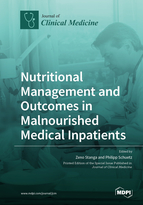Nutritional Management and Outcomes in Malnourished Medical Inpatients
A special issue of Journal of Clinical Medicine (ISSN 2077-0383). This special issue belongs to the section "Endocrinology & Metabolism".
Deadline for manuscript submissions: closed (31 December 2019) | Viewed by 311221
Special Issue Editors
Interests: malnutrition; nutritional management; nutrtitional therapy; refeeding syndrome
Interests: malnutrition; nutritional management; nutrtitional therapy; refeeding syndrome
Special Issue Information
Dear Colleagues,
Malnutrition lurks in the background of hospitalized medical patients. A large proportion of patients are malnourished upon hospital admission and patients often experience further nutritional deterioration during their stay and during disease recovery. However, although the negative effects of malnutrition on the outcomes of patients have been well recognized, we still struggle to identify appropriate patients and efficacious nutritional interventions to overcome this problem. Still, recent studies have produced convincing evidence that adequate and timely nutritional management of medical in-patients can contribute to the prevention of negative consequences and thus improve the clinical outcome of patients.
This Special Issue of the Journal of Clinical Medicine will focus on multiple practical aspects of nutritional management in medical in-patients, from screening for nutritional risk to the practical implementation of nutritional therapy, its possible complications, including financial aspects, to increase clinician awareness and knowledge of nutritional care in hospitals.
Prof. Dr. med. Zeno Stanga
Prof. Dr. med. Philipp Schuetz
Guest Editors
Manuscript Submission Information
Manuscripts should be submitted online at www.mdpi.com by registering and logging in to this website. Once you are registered, click here to go to the submission form. Manuscripts can be submitted until the deadline. All submissions that pass pre-check are peer-reviewed. Accepted papers will be published continuously in the journal (as soon as accepted) and will be listed together on the special issue website. Research articles, review articles as well as short communications are invited. For planned papers, a title and short abstract (about 100 words) can be sent to the Editorial Office for announcement on this website.
Submitted manuscripts should not have been published previously, nor be under consideration for publication elsewhere (except conference proceedings papers). All manuscripts are thoroughly refereed through a single-blind peer-review process. A guide for authors and other relevant information for submission of manuscripts is available on the Instructions for Authors page. Journal of Clinical Medicine is an international peer-reviewed open access semimonthly journal published by MDPI.
Please visit the Instructions for Authors page before submitting a manuscript. The Article Processing Charge (APC) for publication in this open access journal is 2600 CHF (Swiss Francs). Submitted papers should be well formatted and use good English. Authors may use MDPI's English editing service prior to publication or during author revisions.
Keywords
- Nutritional management
- Malnutrition
- Refeeding syndrome
- Oral nutrition
- Enteral nutrition
- Parenteral nutrition
- Costs
- Nutritional screening
- Nutritional assessment







